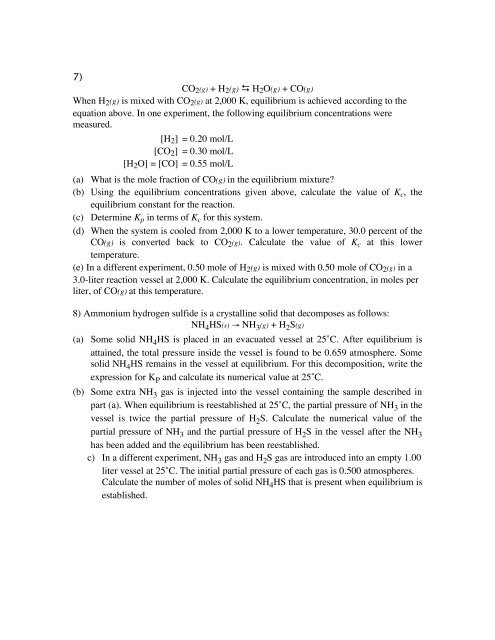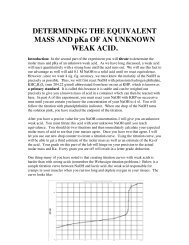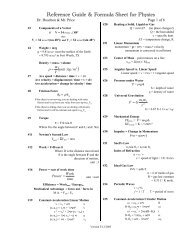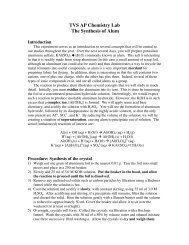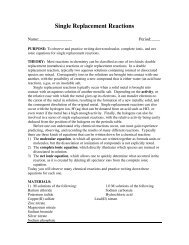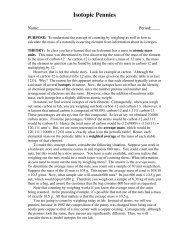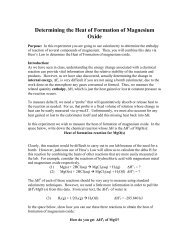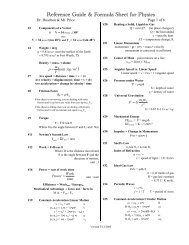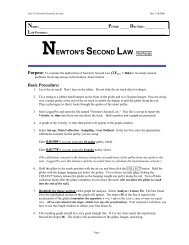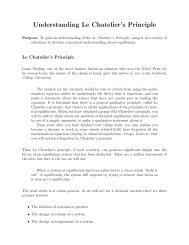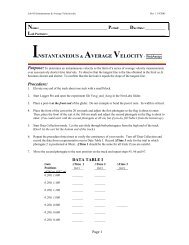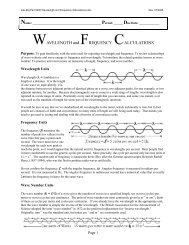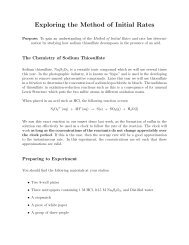Equilibrium Problems II
Equilibrium Problems II
Equilibrium Problems II
You also want an ePaper? Increase the reach of your titles
YUMPU automatically turns print PDFs into web optimized ePapers that Google loves.
7)<br />
CO 2 (g) + H 2 (g) H 2 O(g) + CO(g)<br />
When H 2 (g) is mixed with CO 2 (g) at 2,000 K, equilibrium is achieved according to the<br />
equation above. In one experiment, the following equilibrium concentrations were<br />
measured.<br />
[H 2 ] = 0.20 mol/L<br />
[CO 2 ] = 0.30 mol/L<br />
[H 2 O] = [CO] = 0.55 mol/L<br />
(a) What is the mole fraction of CO(g) in the equilibrium mixture?<br />
(b) Using the equilibrium concentrations given above, calculate the value of K c , the<br />
equilibrium constant for the reaction.<br />
(c) Determine K p in terms of K c for this system.<br />
(d) When the system is cooled from 2,000 K to a lower temperature, 30.0 percent of the<br />
CO(g) is converted back to CO 2 (g). Calculate the value of K c at this lower<br />
temperature.<br />
(e) In a different experiment, 0.50 mole of H 2 (g) is mixed with 0.50 mole of CO 2 (g) in a<br />
3.0-liter reaction vessel at 2,000 K. Calculate the equilibrium concentration, in moles per<br />
liter, of CO(g) at this temperature.<br />
8) Ammonium hydrogen sulfide is a crystalline solid that decomposes as follows:<br />
NH 4 HS(s) → NH 3 (g) + H 2 S(g)<br />
(a) Some solid NH 4 HS is placed in an evacuated vessel at 25˚C. After equilibrium is<br />
attained, the total pressure inside the vessel is found to be 0.659 atmosphere. Some<br />
solid NH 4 HS remains in the vessel at equilibrium. For this decomposition, write the<br />
expression for K P and calculate its numerical value at 25˚C.<br />
(b) Some extra NH 3 gas is injected into the vessel containing the sample described in<br />
part (a). When equilibrium is reestablished at 25˚C, the partial pressure of NH 3 in the<br />
vessel is twice the partial pressure of H 2 S. Calculate the numerical value of the<br />
partial pressure of NH 3 and the partial pressure of H 2 S in the vessel after the NH 3<br />
has been added and the equilibrium has been reestablished.<br />
c) In a different experiment, NH 3 gas and H 2 S gas are introduced into an empty 1.00<br />
liter vessel at 25˚C. The initial partial pressure of each gas is 0.500 atmospheres.<br />
Calculate the number of moles of solid NH 4 HS that is present when equilibrium is<br />
established.


